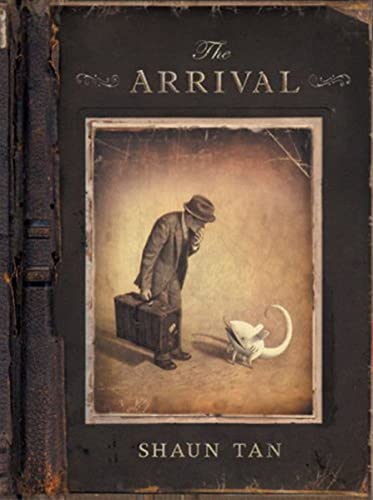Welcome, fellow book explorers! Today, I’m reviewing Arrival book—a wordless wonder that grabbed me by the feels and refused to let go. This is not your usual “read and forget” picture book. Instead, it’s a wild ride through strange lands, strange food, and even stranger cats. I got together with my friends and spent a good hour arguing about what some of the pictures meant—spoiler alert: none of us really agreed! In this review, I’ll walk you through the book’s stunning art, its story about moving to a new place, and why it had us squinting at the pages like detectives. Let’s get started!
In a nutsheel
The Arrival by Shaun Tan is a wordless graphic novel that tells the story of one man’s journey to a strange new world. It’s like a silent movie you read with your eyes (and yes, sounds weird, but trust me, it works).
This book falls into the fantasy and graphic novel genres. It’s aimed at both adults and kids, which makes it great for family reading time, unless your kid eats books (mine did once, but that was a long story).
The main themes are migration, hope, and the feeling of being lost in a new place. Shaun Tan’s amazing art shows the confusion, wonder, and sometimes fear of starting over in a place where nothing makes sense. If you’ve ever felt out of place or started fresh somewhere new, you’ll know exactly how this book ‘feels.’
How ‘Arrival’ Paints a Story Without Words: Visual Storytelling and Illustration Style
If there was ever a book that could make me cry over a suitcase, it’s Arrival by Shaun Tan. This book took one glance at language and said, ‘Nah, I’ll draw it!’ I remember showing it to my friend Tom and watching him try to find the words on each page. He kept flipping the book upside down. Sorry Tom, the story is in the pictures, not the paragraphs!
Every page is a gem. The illustrations are all in soft, sepia tones, kind of like the old photos my grandma keeps in her attic. Tan uses shades and lighting to set the mood. You will see a man hugging his family goodbye in one panel and then feel his loneliness as he walks through strange crowds in another. These images kick you straight in the feels without a single word spoken.
What really got me is how Tan makes everything look both familiar and bizarre. There are creatures that look like they might eat your sock, and buildings that bend reality. It shows how strange a new place can feel when you don’t know the rules. I once moved to a new city and got lost looking for the bus. I wish I had a Tan-style map.
Some folks might find the lack of text tough at first, but stick with it. The story unfolds like a dream—one you can visit again and again. And the art? Just wow. It’s a real treat for your eyeballs, but maybe not for your dictionary.
Next up, let’s unpack (pun intended) the themes of migration and displacement that make Arrival so much more than a pretty picture book!
The Theme of Migration and Displacement in The Arrival Book
If there’s one thing that “The Arrival” book nails, it’s the feeling of being a total fish out of water – and not even the tasty kind you find at a sushi bar. Shaun Tan, who wrote and drew the book, gives us a story about leaving one place to find another, and boy, does he hit every strange, awkward, and scary note.
In the book, a man leaves his home and travels far to get somewhere safe for his family. You know that feeling when you arrive at a party and realize you’re at the wrong house? Multiply that by a hundred. The book pulls you into the main character’s confusion as he struggles to understand the weird new language, customs, and, let’s be honest, some very wonky-looking animals. No maps, no translation, just a suitcase and lots of hope. I felt like I needed my mom just reading some pages.
What really stands out is how the story tells so much about migration without using a single world—er, word. The illustrations do all the talking. I read this with my friends, and every one of us saw something different in the scenes: my buddy Fred said it looked like his grandpa’s old stories about coming to America. I saw echoes of my family moving cross-country (with less magic but more traffic).
From sad goodbyes to the odd joy of new friendships, “The Arrival” gets that migration is not just moving luggage but also hearts and dreams. Next up, I’ll spill the beans (and maybe my coffee) about the emotional punches this book throws at readers. Stay tuned for all the feels!
How “Arrival Book” Tugs at Your Heartstrings
I’ll be real with you: reading “Arrival Book” turned me into a human puddle more than once. You know that fine line between sadness and hope? Shaun Tan draws it with a pencil so sharp, it pokes you right in the feelings. Even though the book doesn’t have any words, the emotions sort of leak out of the pages and into your lap. It’s wild.
I let my buddy Jerry read it and I swear he got misty when the main character stares at that strange city for the first time. The confusion and longing in the character’s eyes took him back to his first day at a new school, when he thought the lunch lady was asking him to fight her (turns out she just wanted to know if he wanted fries). They say pictures speak louder than words; this book is like a stadium concert of feels. The loneliness, the wonder, the small joys of making a new friend or catching a lucky break—they’re all in there, making you root for this lost, brave soul.
Sometimes, I return to a page in “Arrival Book” just to soak in a little more of that big, splashy empathy. I never thought I’d get so swept up by a story with no words, but here we are! Of course, if you’re a cold-hearted robot, you might not feel a thing. But for the rest of us, it’s like getting a hug from your memories of being the new kid somewhere strange.
Next, hold onto your hat, because we’ll peek into the wild and weird world-building that makes “Arrival Book” stand out!
Unpacking the Mind-Bending World-Building in Arrival
One thing that smacked me right between the eyes while flipping through Arrival was just how bonkers the world-building gets. Shaun Tan doesn’t stop at odd creatures or wacky landscapes. No, he goes all in. The book’s world feels like someone turned reality upside down, tossed it in a blender, and still managed to pour out a story you can feel in your bones.
Take the gadgets. I saw suitcases that looked like they’d have social media apps in 1905. There are pets with more arms than my Aunt Edna has toes. Every page has clues about how this world ticks—like how people eat, talk, or even tie their shoes (spoiler: it’s not with laces). Sometimes I’d spot a weird building in the background and spend five minutes trying to figure out what it’s for. If you like games of spot-the-oddity, you’re in for a treat.
What I really respect about Arrival’s world-building isn’t just the details, but how those details make you think about your own place in the world. Nothing is explained, so you get to play detective, which makes you care more about the story. It’s genius, really. Also a bit frustrating when you want answers, but hey, life’s a mystery too.
If you want a book that sets your imagination on fire without making your brain hurt, I totally recommend Arrival. Just be ready for some wild pictures and stranger worlds!
Conclusion
So there you have it, folks—my review of Shaun Tan’s ‘The Arrival.’ This book stands out with its amazing art, wild world-building, and heartfelt story about migration. Sure, you won’t find a single word in it, but honestly, half the books I read should try this trick—I’d get through them a lot faster! ‘The Arrival’ is a journey of feelings, confusion, and hope, all drawn so well it almost made me forget I can’t draw a straight line. If you like stories that make you think and stare at pictures for ages, this one’s for you. But if you really need words, maybe stick to ‘Where’s Waldo.’ Anyway, that’s a wrap for my review. Now, if you’ll excuse me, I’m off to see if I can move to a world with flying toast. Happy reading!


